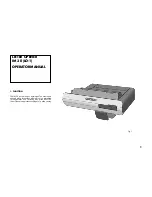
RP0290-2000
6
NACE International
3.5.12 Redundancy of current output, circuitry, and
monitoring components and the capacity to readily
isolate sections of the impressed current cathodic
protection system can be beneficial. These features
can minimize the area affected by a malfunction or
physical damage.
_______________________________________________________________________
Section 4: Installation Practices
4.1 It is critical for the successful operation of the
impressed current cathodic protection system that all
materials and equipment be installed according to
manufacturer’s and design specifications. Installation
procedures include intermediate testing, quality assurance
of materials, and application restrictions. Materials and
installation practices should conform to applicable codes
and standards such as the National Electrical Code, those
issued by OSHA, NEMA, NACE, ACI, ASTM, and any other
applicable codes or standards.
4.2 Quality assurance of materials should be made by
acceptance of manufacturer’s certification, on-site test, or
sample testing in a qualified independent laboratory.
Quality assurance requirements should be clearly stated in
the design specifications.
4.3 Ongoing inspection and testing shall be conducted
throughout construction to ensure that design and
manufacturer’s specifications are met and recorded.
4.3.1 Electrical continuity or isolation requirements
between reinforcing bars and other embedded metals
must be verified.
4.3.2 Equipment used for installation shall be in
accordance with manufacturer’s specifications and any
other conditions specified by the material’s
manufacturer or design specifications.
4.3.3 Pertinent storage and application restrictions
should be given in the design specifications. Such
restrictions include, but are not limited to, temperature,
relative humidity, surface moisture content, and surface
preparation.
_______________________________________________________________________
Section 5: Energizing and System Adjustment
5.1 This section presents recommended procedures for the
energizing and adjustment of an impressed current cathodic
protection system.
5.2 Component Installation Inspection
5.2.1 Prior to energizing, the AC service to the
cathodic protection system shall be inspected for
compliance with the National Electrical Code and such
local codes and ordinances that may be applicable or
in force. It shall be verified that the AC service voltage,
phase, and wiring size are compatible with the cathodic
protection rectifier.
5.2.2 Prior to energizing, the rectifier shall be
inspected. The integrity of all AC input and DC output
connections shall be verified. All mechanical fasteners
shall be inspected and tightened or replaced if
appropriate.
5.2.3 The primary and, if appropriate, secondary
anodes, including feed circuitry, shall be visually
inspected for proper installation. It shall be established
that no short circuits exist between any anode material
and any metal embedments.
5.2.4 The electrical continuity between all the steel
reinforcement and other metal embedments intended
to be cathodically protected shall be tested at
accessible locations.
5.2.5 Electrical isolation of metal mounted on, in, or
adjacent to the protected concrete structure and not
designed to be cathodically protected should be
verified.
5.2.6 All reference and monitoring devices and
attendant hardware shall be inspected for proper
installation and operation in accordance with the
manufacturer’s instructions and design specifi-cations.
The open-circuit potential of all permanent reference
electrodes shall be measured against a closely placed,
calibrated, stable portable reference electrode.
5.2.7 Additional cathodic protection equipment and
associated components shall be inspected for proper
installation and operation in accordance with the
manufacturer’s instructions and design specifi-cations.
5.3 System Energizing and Adjustment
5.3.1 After completion of the component installation
inspection, the impressed current cathodic protection
system shall be energized. Each rectifier shall be
turned on and operated manually at not more than 20%
of the full rated maximum design current output.
Содержание CP 1
Страница 1: ...CP 1 Cathodic Protection Tester Course Manual February 2005 NACE International 2000 ...
Страница 265: ......
Страница 266: ......
Страница 267: ......
Страница 268: ......
Страница 301: ...RP0169 2002 32 NACE International ISBN 1 57590 035 1 ...
Страница 535: ...TM0101 2001 24 NACE International ISBN 1 57590 137 4 ...
















































